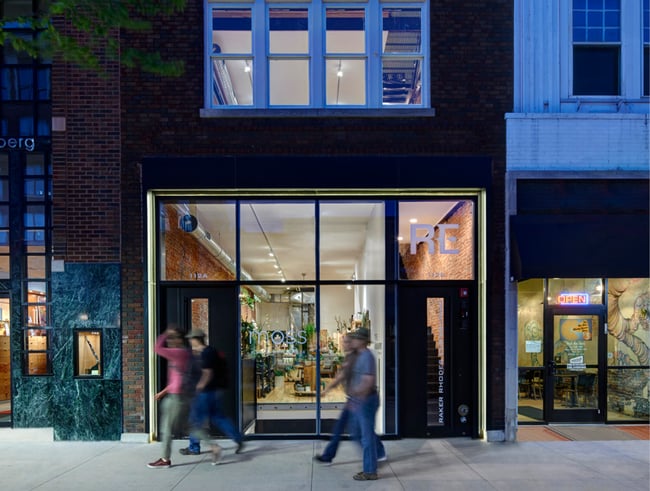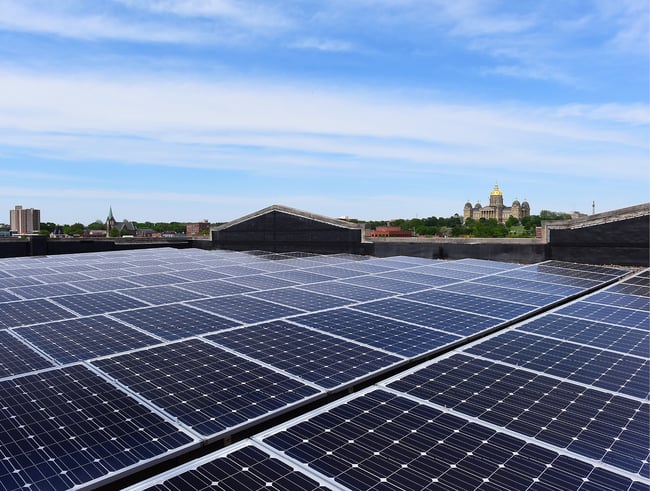Factors that Impact the Sustainability of a Building Site

Selecting a site is one of the first steps of a building project. Although this process can feel overwhelming, an architect can provide direction.
To help with site selection, your architect will evaluate several criteria, including the site’s sustainability. Some sites are more sustainable than others and assessing your options can help you find a location that reduces carbon emissions, strengthens your community, and even lowers the cost of building operations.
We have helped many building owners through the site selection process—including the Stanley Center for Peace and Security, a project on track to become the first fully certified Living Building in Iowa.
This article will build off that experience and discuss four factors that have the greatest impact on the sustainability of a building site:
- Proximity to existing development
- Solar access
- Hardscape and stormwater management
- Zoning restrictions and neighborhood context
After reading, you’ll better understand what to consider when evaluating potential locations for your new building.
4 Factors that Impact Site Sustainability
1. Proximity to Existing Development
Building rating systems like LEED and Living Building Challenge promote the practice of developing a site in an existing area. Dense areas like downtowns are walkable and close to amenities like public transportation, reducing the carbon emissions associated with commuting and the need for surface parking lots.
When researching sites, it helps to look at the services provided in an existing neighborhood and explore how your project can align. Ideally, a project will contribute to a neighborhood’s vibrancy and improve connectivity for residents.
Developing in existing areas also reduces urban sprawl and helps preserve farmland, wildlife habitats, and other resources. Although greenfield sites can be appealing, they are less likely to provide water connections and utility hookups. Connecting this infrastructure to a new site can increase project costs.

Developing in dense, walkable neighborhoods reduces urban sprawl.
Existing Buildings
Sites in existing areas may come with existing buildings. Rather than a hindrance, an existing building can be an opportunity. After all, the most sustainable building already exists.
Redeveloping an existing building reduces the embodied carbon associated with demolition and construction, and often, older buildings contain characteristics that contribute to a community’s identity.
Despite the benefits, existing buildings and their sites come with risks. Some sites—like brownfields—may be contaminated and require remediation before construction. However, these risks are manageable, and rehabilitating the land can open the door for funding opportunities and tax credits.
2. Solar Access
Solar access is another factor that contributes to a building site’s sustainability.
Ideally, the site will allow your architect to position the building for passive heating and cooling. The best sites provide longer east-west footprints and greater southern exposure.
A site analysis can also help determine the site’s potential for solar energy production. An architect can evaluate where to place solar panels and the number of panels the site can support.
Even if solar panels are outside your initial project budget, it helps to consider the possibility of future on-site energy production.

A site analysis can measure the potential for solar energy production.
3. Hardscape and Stormwater Management
Paved surfaces—also known as “hardscape”—can pose water management challenges. Hardscape prevents rainwater from saturating the soil, increasing the risk of flood events and drinking water contamination.
Reducing hardscape and increasing soil and vegetation—known as “softscape”—is the most sustainable practice. When selecting a site, it helps to evaluate the amount of hardscape and determine whether demolition work is necessary.
In urban settings, reducing hardscape can prove challenging, but increasing softscape through plantings and green roofs can help mitigate runoff. These spaces can also provide outdoor recreation opportunities for occupants and benefit birds, bees, and other wildlife.

Increasing soil and vegetation helps with stormwater management.
4. Zoning Restrictions and Neighborhood Context
Often, site selection includes an analysis of zoning restrictions. While it may not be obvious, these restrictions can present constraints that affect a project’s sustainability.
For example, some municipalities may have parking requirements, adding to hardscape. Other municipalities may have setback requirements and material restrictions, which can impact building performance. Surrounding building heights can even affect daylight access and pose problems for solar power production.
Zoning can get complicated, but an architect’s job is to find ways to design within these restrictions. Depending on the area, you may be able to make a case for stretching or reinterpreting the requirements to meet your project goals.
In addition to zoning, it’s important to consider the neighborhood context. Some areas may contain historic architectural styles that create expectations for new construction.
These expectations may challenge conventional approaches to green design. However, as with zoning laws, context can create an opportunity for a unique approach. Your architect can help you weigh your options and prepare for potential challenges.
Learn More About Site Selection
Sustainable design starts with the right location. A detailed analysis of each potential site can help you weigh the pros and cons and find a location that aligns with your goals.
Along with sustainability, the site selection process should include an analysis of your project priorities. Perhaps you want a site in an area with heavy foot traffic or need room to expand your operations.
In our experience, the site selection process is most effective when it follows a visioning workshop. These workshops include a large group of stakeholders and help you set high-level project goals. A solid understanding of your goals creates a set of criteria for vetting future design decisions.
Learn more by reading about the visioning workshop experience.